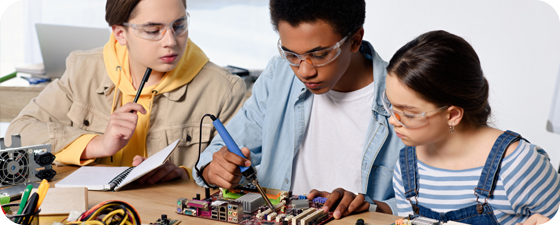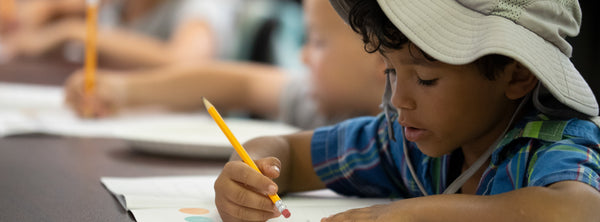
Building Diverse Makerspaces
This webinar took place on:
Wednesday, October 10, 2018
At: 2:30 PM MST
PCS Edventures' lead trainer,Tyler Downey, was joined by Erin Downey (VP Idaho Libray Association), Sonia Galaviz (Multi-Award Winning Teacher) and Nick Grove (Unbound Meridian Library Makerspace) to explore:
- What is a Makerspace?
- How can we promote diversity in our Makerspaces?
- What does a diverse Makerspace look like?
- What are some practical strategies for cultivating diverse and inclusive Makerspaces?
- PCS Products for Makerspaces
- Q&A
Enjoy the video:
Webinar Resources
Webinar Q&A's
Q: In what ways do you believe the Makerspace movement enhances or competes with traditional education? Will it become equal to core competencies?
Response by Sonia: It enhances the content and curriculum that I’m currently teaching. It provides that uptake from a 2-D understanding to a 3-D creative process where students are able to design within a particular area or subject. It is not seen as rigorous compared to traditional book study or research report, but it truly is. We need to be the ones to advocate and talk about the rigor and grit and perseverance that is required to exist in that space and utilize Makerspaces to make connections. If you’re embedding it within the context areas, the students have to make connections and do some reading and write about it and justify their design and incorporate it a variety of different ways. The fact of the matter remains that we have substantial gaps in our STEM education. Careers are out there with no people to fill them. Not only are we lacking in the science and technology and math content, but also the 21st Century skills that are needed. Our local industry has expressed that job-seekers are lacking soft skills—our workforce doesn’t know how to communicate or problem-solve or work in a team—so that is what we are developing in these spaces as well. We have to continue to advocate for that space to incorporate those 21st Century skills, connect to the content and allow students some creativity that may transfer into a career later in life.
Q: I am a foreign language teacher, I find integrating STEAM challenging as there are not many resources available. Do you guys have any ideas ? Have you seen it integrated in your workplaces?
Response by Sonia: A makerspace would be a perfect opportunity to explore the target country of the language you are studying. For example, if you are in a Spanish class, maybe students could build a model of some of the indigenous ruins of that area and present in the target language. Maybe they are able to look at some of the things archaeologists have uncovered that we don’t know much about and design a use for it. Another option would be to create a map of the country and program a robot to travel to different sites where significant historical events took place. All of these activities could utilize specific vocabulary within the context of a STEAM challenge. Allow yourself to create that space in the classroom and have the kids hit target nouns, verbs, and conjugations in the context of what they’ve created and designed.
Response by Nick: If you are working in the context of a classroom teaching English as a second language, Makerspaces are a great opportunity there as well. Pipe cleaners, scissors, cardboard, duct tape — those don’t have language written on them. They can be taught in any language without a lot of instruction. Breaking down the barrier of what can be done is not too hard. It can be done for any age group or language. A maker activity will lead itself in a lot of ways. With a little direction, you can have a lot of awesome projects taking place.
What products does PCS Edventures offer to educators who want to start Makerspaces?
Response by Tyler: We have a whole variety of products that would be excellent for starting Makerspaces. Our STEM carts would be especially fitting for this context. These Discover STEM Labs for grades 3-4 and 5-6 each include four kits — one each for Science, Technology, Engineering and Math. Every kit includes 12 hands-on activities that students can use in a self-guided way. They are meant to be exploratory rather than dictatorial. Open-ended exploration is the goal!
Makerspace Blog Posts
To keep exploring the possibilities for your own; Makerspace, check out these articles:
- Choosing What’s Best for Your Makerspace
- How to Create a Safe, Secure and Successful Makerspace
- The 7 Makerspace Mandates
- The Power of Organizing Your Makerspace
Subscribe to be alerted of upcoming webinars
Want to be the first to hear about the next STEM education webinar? Subscribe to our newsletter by clicking the button below.








